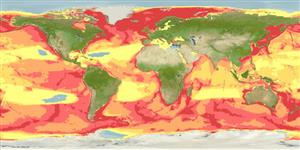Common names from other countries
Environment: milieu / climate zone / depth range / distribution range
Ecologie
; brakwater; diepteverspreiding 0 - 732 m (Ref. 116169). Tropical; 90°N - 90°S, 180°W - 180°E
Circumglobal: Balaenoptera acutorostrata acutorostrata: North Atlantic; Balaenoptera acutorostrata scammoni: North Pacific (Ref. 1522).
Length at first maturity / Size / Gewicht / Leeftijd
Maturity: Lm ? range ? - ? cm Max length : 1,070 cm TL mannelijk/geslacht niet bekend; (Ref. 1394); 1070 cm TL (female); Maximaal gepubliceerd gewicht: 14.0 t (Ref. 1394)
Distributed from the tropics to the ice edges in both hemispheres. They can be seen offshore, and more often in coastal and inshore areas. They are rarely seen in some tropical pelagic areas. Minimum depth from the Pacific (Ref. 83490) and maximum depth based from their food in the Atlantic (Ref. 83488). Feeds on krill and small schooling fishes (Ref. 1394). Oceanodromous (Ref. 75906). Distributed from the tropics to the ice edges in both hemispheres. They can be seen offshore, and more often in coastal and inshore areas. They are rarely seen in some tropical pelagic areas (Ref. 1394). They are known to be 'gulpers,' feeding in separate events, often lunging at large schools of fish (Ref. 122680). Also feeds on krill (Ref. 1394). Oceanodromous (Ref. 75906).
Jefferson, T.A., S. Leatherwood and M.A. Webber. 1993. (Ref. 1394)
Status op de Rode Lijst van het IUCN (Ref. 130435)
Status bij CITES (Ref. 108899)
Not Evaluated
Gebruik door de mens
Visserij: commercieel
FAO - Visserij: landings, soortsprofiel | FishSource | Sea Around Us
Tools
Internet-bronnen
Estimates based on models
Preferred temperature
(Ref.
115969): 0.2 - 11.2, mean 2.9 (based on 10218 cells).
Weerstandsvermogen
Gemiddeld, minimale populatieverdubbelingstijd 1,4-4,4 jaar (K=0.17; tm=8).
Kwetsbaarheid
High vulnerability (63 of 100).
Prijsklasse
Unknown.
